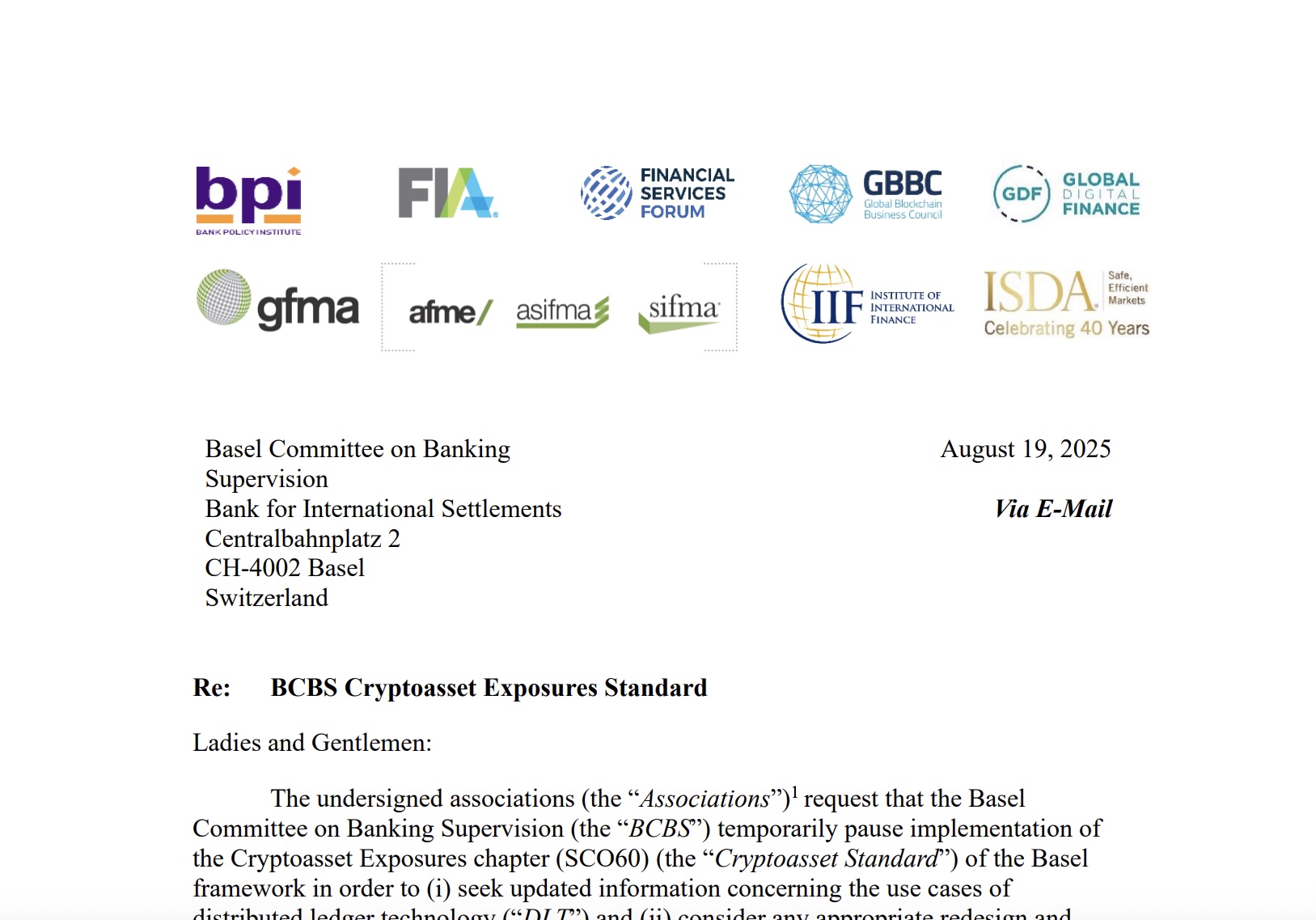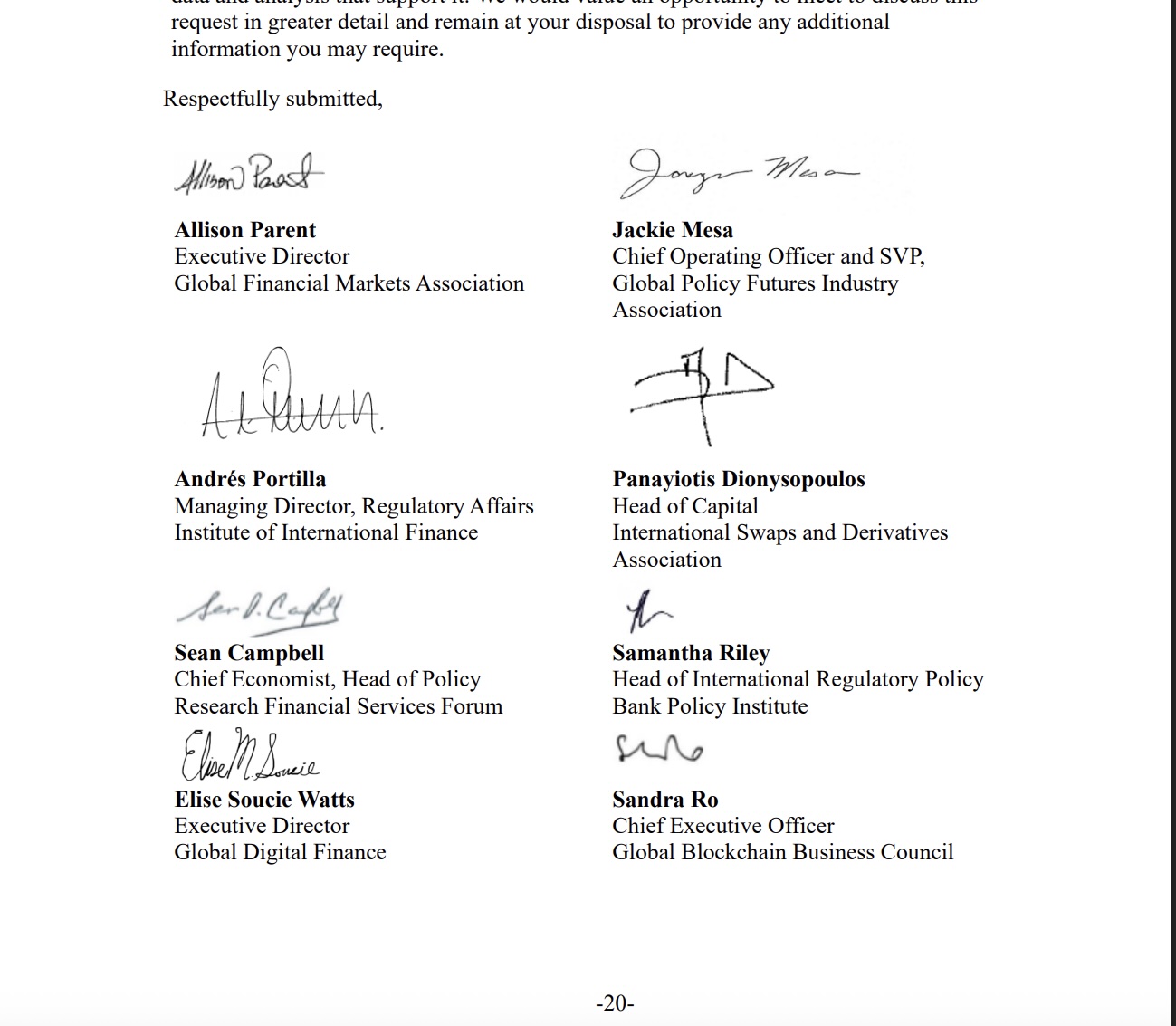Wall Street to Basel: don’t freeze crypto rules in 2021

Eight Wall Street trade groups urge the Basel Committee to update bank capital rules for crypto – arguing tokenized Treasuries and fully backed stablecoins shouldn’t be treated like speculative coins.
Eight major banking trade groups – led by the Global Financial Markets Association (GFMA) and the Institute of International Finance (IIF) – have sent a 20‑page letter to the Basel Committee on Banking Supervision (BCBS). Their message is clear: the draft global bank‑capital rules for crypto are too broad and inflexible. As written, they say, the rules would lump tokenized Treasuries and fully‑backed stablecoins together with speculative coins, making it uneconomic for regulated banks to touch on‑chain finance at all.

What’s at stake
BCBS sets the template national regulators use to calibrate risk and capital. Its crypto standard – drafted in the aftermath of 2022’s blowups – puts most crypto exposures in a high‑penalty bucket with tight caps. Banks argue that the market has evolved: tokenized cash and securities now clear on permissioned networks, custody tech has matured, and on‑chain settlement can reduce post‑trade risk. If the calibration doesn’t change, they say, activity won’t disappear; it will migrate to non‑banks and offshore venues.
What the associations are asking for (in plain English)
The letter doesn’t ask to deregulate crypto. It asks Basel to update the plumbing so banks can participate in safer segments without punitive capital. The core requests boil down to:
- Same risk, same rules: Treat tokenized real‑world assets (e.g., Treasuries, commercial paper) like their off‑chain equivalents when legal structure and redemption are the same – instead of defaulting them to the highest‑risk crypto bucket.
- Differentiate stablecoins: Recognize fully‑reserved, redeemable stablecoins under clear rules as cash‑like for capital and liquidity treatment; don’t lump them with volatile tokens.
- Count hedges and netting: Allow normal recognition of hedges, netting sets, and collateral for on‑chain exposures so banks aren’t capitalized as if unhedged.
- Clarify custody treatment: Clarify that client crypto held under proper segregation stays off the bank’s balance sheet (and define the controls to make that true).
- Enable on-chain settlement: Permit supervised pilots for repo, securities lending, and delivery‑versus‑payment on DLT, with capital aligned to the underlying asset and counterparty, not to the tech used.
- Operational tokens ≠ investments: Distinguish “gas” or utility tokens used to run networks from speculative positions when calculating exposure caps.
- Avoid double counting risks: Don’t charge both technology risk and market/credit risk where traditional controls (legal finality, bankruptcy‑remote structures, KYC/AML) address the real exposure.

Why banks care
Under today’s draft, a bank that tokenizes a Treasury and settles it on a permissioned ledger could face the same capital hit as if it held a volatile coin outright. This calculation makes the business case unviable. Banks also want clarity that when they safeguard client tokens under strict segregation, they won’t be treated as if they own those assets. Finally, they need Basel to recognize hedges and netting; otherwise, they have to carry capital as if nothing is offset.
Why regulators care
Basel’s job is to protect the system. The committee leaned conservative after the 2022 failures – rightly worried about runs, opacity, and leverage. The trade groups argue that better calibration would improve safety by bringing tokenization and stablecoin flows into supervised banks, with capital matched to the real risk (the issuer, the counterparty, the asset), not to the database it runs on. If rules remain inflexible, the risk is clear: critical payment and settlement activity will migrate outside regulatory oversight.
The real fight: calibration, not ideology
Both sides accept that banks must hold capital, manage liquidity, and prove legal control when they use DLT. The dispute is about how much capital, for what risk, and when pilots can scale. Expect the haggling to focus on definitions (what counts as a “high‑quality” stablecoin), legal structure (how tokenized assets are ring‑fenced), custody segregation, and whether exposure limits apply before or after hedging.
Our take
This is a bid to turn on‑chain finance from a shadow activity into bank‑grade infrastructure. The letter keeps the ask for crypto deregulation: don’t rewrite Basel, but stop treating every on‑chain use case like a speculative bet. A likely compromise: clearer custody rules, recognition of hedges, carve‑outs for permissioned DLT pilots, and a tighter definition of stablecoins that can earn cash‑like treatment. Less likely: scrapping exposure caps entirely.
What to watch next
Basel’s consultation timeline and any follow‑up technical notes; how the EU, UK, and U.S. translate the standard into local rules; and, most importantly, whether tokenized cash and securities get capital treatment that reflects their underlying risk. If that happens, banks will test real settlement flows on the chain, revealing whether the promised cost and risk reductions materialize in practice.
Content on BlockPort is provided for informational purposes only and does not constitute financial guidance.
We strive to ensure the accuracy and relevance of the information we share, but we do not guarantee that all content is complete, error-free, or up to date. BlockPort disclaims any liability for losses, mistakes, or actions taken based on the material found on this site.
Always conduct your own research before making financial decisions and consider consulting with a licensed advisor.
For further details, please review our Terms of Use, Privacy Policy, and Disclaimer.



























